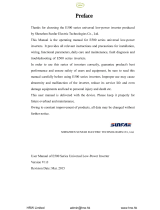
Section, Page No. Changes
Errata to PowerPC™ e500 Core Family Reference Manual, Rev. 1
4 Freescale Semiconductor
2.10.2, 2-29 In Table 2-15, revise the description of HID1[RFXE] as follows:
2.12.1, 2-36 In the PIDn registers, revise the Process ID field of the register as follows:
46 RFXE Read fault exception enable. Enables the core to internally generate a machine check interrupt when core_fault_in
is asserted. Depending on the value of MSR[ME], this results in either a machine check interrupt or a checkstop.
0 Assertion of core_fault_in cannot cause a machine check. The core does not execute any instructions from a
faulty instruction fetch and does not execute any load instructions that get their data from a faulty data fetch.
On the e500v2, if these instructions are eventually required by the sequential programming model (that is, they
are not in a speculative execution path), the e500v2 stalls until an asynchronous interrupt is taken. The e500v1
does not stall when faulty instructions or data are received, as described in the following note.
Note: The e500v1 does not stall when faulty instructions or data are received. Instead, it continues processing
with faulty instructions or data. The only reliable way to prevent such behavior is to set RFXE, which causes a
machine check before the faulty instructions or data are used. To avoid the use of faulty instructions or data and to
have good error determination, software must set RFXE and program the PIC to interrupt the processor when
errors occur. As a result, software must deal with multiple interrupts for the same fundamental problem.
1 Assertion of core_fault_in
causes a machine check if MSR[ME] = 1 or a checkstop if MSR[ME] = 0.
The core_fault_in
signal is asserted to the core when logic outside of the core has a problem delivering good
data to the core. For example, the front-side L2 cache asserts core_fault_in when an ECC error occurs and ECC
is enabled. As a second example, it is asserted when there is a master abort on a PCI transaction. See Section
13.8, "Proper Reporting of Bus Faults."
The RFXE bit provides flexibility in error recovery. Typically, devices outside of the core have some way other than
the assertion of core_fault_in
to signal the core that an error occurred. Usually, this is done by channeling interrupt
requests through a programmable interrupt controller (PIC) to the core. In these cases, the assertion of
core_fault_in is used only to prevent the core from using bad data before receiving an interrupt from the PIC (for
example, an external or critical input interrupt). Possible combinations of RFXE and PIC configuration are as
follows:
• RFXE = 0 and the PIC is configured to interrupt the processor. In this configuration, the assertion of
core_fault_in
does not trigger a machine check interrupt. The core does not use the faulty instructions or data
and may stall. The PIC interrupts the core so that error recovery can begin. This configuration allows the core
to query the PIC and the rest of the system for more information about the cause of the interrupt, and generally
provides the best error recovery capabilities.
• RFXE = 1 and the PIC is not configured to interrupt the processor. This configuration provides quick error
detection without the overhead of configuring the PIC. When the PIC is not configured, setting RFXE avoids
stalling the core when core_fault_in
is asserted. Determination of the root cause of the problem may be
somewhat more difficult than it would be if the PIC were enabled.
• RFXE = 1 and the PIC is configured to interrupt the processor. In this configuration, the core may receive two
interrupts for the same fundamental error. The two interrupts may occur in any order, which may complicate error
handling. Therefore, this is usually not an interesting configuration for a single-core device. This may, however,
be an interesting configuration for multi-core devices in which the PIC may steer interrupts to a processor other
than the one that attempted to fetch the faulty data.
• RFXE = 0 and the PIC is not configured to interrupt the processor. This is not a recommended configuration.
The processor may stall indefinitely due to an unreported error.
SPR
SPR
SPR
48 (PID0: PID in Book E);
633 (PID1: e500-specific);
634 (PID2: e500-specific)
Access: Supervisor-only
32 55 56 63
R
— Process ID
W
Reset All zeros
Figure 2-24. Process ID Registers (PID0–PID2)









